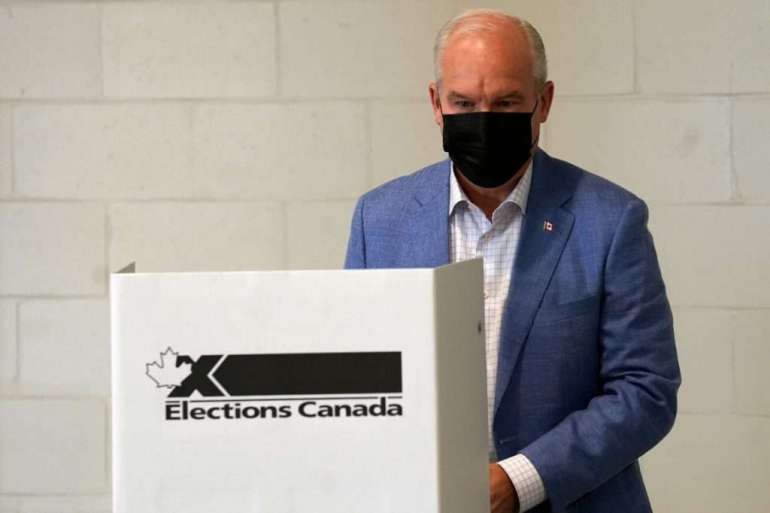Canadian Conservative leader tested leftward shift against Trudeau. Will the new course stick?

His strategic shift included a climate plan, with a price on carbon, and a different tone on LGBTQ2 issues.
“I told Conservatives that our party needed the courage to change because Canada has changed,” O’Toole said early Tuesday morning in his concession speech. “We have demonstrated to Canadians that we’ve set out on a path to engage more Canadians in our conservative movement.”
The outcome so far: With the votes still being counted Tuesday, the Conservatives appeared to have won 119 seats in Monday’s election. The party took 121 seats in 2019 under O’Toole’s predecessor, Andrew Scheer.
Like 2019, the Conservatives are poised to win the popular vote in Canada’s first-past-the-post electoral system, even though they will finish behind the Liberals in the number of seats.
The complexity of individual voting decisions underpins any election, but the Conservatives will study the data to determine how much O’Toole’s leftward path helped him stay unexpectedly close to Trudeau. O’Toole has also announced that he’s initiated a post-election review.
“We will take stock of what worked and what didn’t and we will continue to put in the time showing more Canadians that they are welcome in the Conservative Party,” O’Toole said in the speech.
“Above all, we must continue to show Canadians that whether you’re Black, white, Brown or from any race or creed, whether you’re LGBTQ, or straight, whether you are an Indigenous Canadian, or came to Canada five weeks ago, or five generations ago … you are an important part of Canada, and you have a place in the Conservative Party.”
High floor, low ceiling: O’Toole made a big bet by breaking away from his predecessors in the party’s top job by pitching himself as “pro-choice,” an ally to the LGBTQ2 community and a conservative with a detailed climate plan.
“We’re not your dad’s Conservative Party anymore,” O’Toole said on a campaign stop late last week.
Some Conservative insiders have described O’Toole’s approach as a bold move for a party that relies on its base support from social conservatives.
The risk was that the campaign, which O’Toole called “socially progressive,” would drive away too many votes at the party’s edges.
In Monday’s vote, the right-wing People’s Party of Canada, led by former Conservative cabinet minister Maxime Bernier, failed to win a seat. But the party grew its support and it appeared to pull enough votes from O’Toole to weaken the Conservative results.
Expanding the voter pool: Sean Speer, who was a policy adviser to former Conservative prime minister Stephen Harper, said when it comes to voter support the Tories have the highest floor among the major parties.
For instance, Speer says the party’s loyal base means a leader can pretty much count on getting at least 26 percent of the vote in any given election.
On the other hand, he said the party also has the challenge of a relatively low ceiling with an approximate maximum, on a good day, of about 35 percent support.
“How to raise the ceiling without dropping the floor has been the challenge that Mr. Toole and his team have rightly identified and have sought to address,” Speer, a senior fellow with the Munk School Global Affairs & Public Policy, told POLITICO before the election results came out. “It’s fair to say that they deserve credit for that.”
He said in 2019 the Conservatives stuck with the well-worn approach of mobilizing and galvanizing their base rather than trying to solve the low-ceiling problem.
Speer said it’s unclear whether the party can successfully expand its reach to a larger pool of voters without bleeding just as much support elsewhere.
“There is an open question about whether there’s a kind of structural problem built into the Conservative Party’s voter composition,” he said.
The early results: A quick glance at Monday’s results suggests voters may have followed O’Toole’s shift.
The Conservatives appeared poised to double their riding wins compared to 2019 with eight seats in more-progressive Atlantic Canada, which was swept by the Liberals in 2015.
But the Tories had a weaker result in Canada’s traditional conservative heartlands of Alberta, Saskatchewan and Manitoba. In Monday’s vote, 11 seats went to other parties in the Prairie region, compared to just eight in 2019.
What’s next: A big unknown is whether O’Toole will be able to keep his job as leader.
His Conservatives beat low expectations at the outset of the campaign, when polls suggested the Liberals were close to majority government territory. Unlike his globally recognized Liberal rival, O’Toole was nowhere near a household name in Canada.
The Conservative leader said he wants to stay on until the next election.
“We are building towards victory next time,” he said at a press conference on Tuesday afternoon. “I have already initiated a post-election review to examine what went right, what went wrong and what we can do better.”
But without a major improvement — or even a dip — in the party’s seat count, he may struggle to do so. O’Toole will also have to answer for veering to the left.
He faced numerous questions from reporters Tuesday about his future as leader.
O’Toole highlighted some of Monday’s gains, including the party taking its first seat in Newfoundland and Labrador in eight years.
“I’m clearly disappointed, all of our members are disappointed that it’s status quo,” O’Toole said as he sidestepped query about whether he would trigger a leadership review. “I’m very, very proud of the gains we made, but we didn’t get far enough. We will next time.”